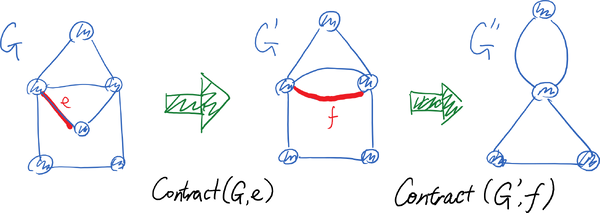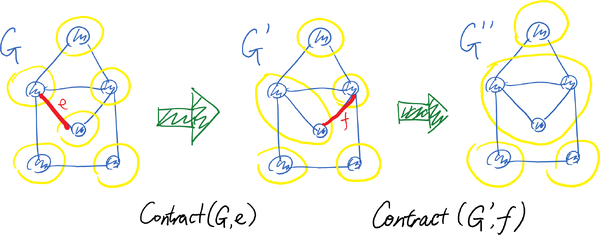概率论与数理统计 (Spring 2024)/Karger's min-cut algorithm: Difference between revisions
| Line 45: | Line 45: | ||
[[Image:Contract_class.png|600px|center]] | [[Image:Contract_class.png|600px|center]] | ||
== | == Karger算法的分析 == | ||
假设输入图 <math>G</math> 为一任意给定的多重图。Karger算法输出了该图的一个随机的割。我们需要分析该随机割是最小割的概率,即如下概率的下界: | |||
:<math>\Pr[\,\text{收缩算法输出了 }G\text{ 的一个最小割}\,]</math> | |||
对此,我们证明如下更强的结论。令 <math>C</math> 是输入图 <math>G</math> 中的某个特定的最小割。我们将分析如下概率的下界: | |||
:<math> | :<math>\Pr[\,\text{收缩算法输出了 }C\,]</math> | ||
显然这一概率是收缩算法成功输出最小割的概率的下界(在这里我们使用了如下概率法则:对任意事件 <math>A</math> 和 <math>B</math>,若 <math>A\subseteq B</math>,则<math>\Pr(A)\le \Pr(B)</math>)。 | |||
我们引入以下记号: | |||
* 令 <math>e_1,e_2,\ldots,e_{n-2}</math> 表示在运行收缩算法时,依次选中进行收缩的随机边的序列; | |||
* 令 <math>G_1=G</math> 表示最初输入的多重图。对于 <math>i=1,2,\ldots,n-2</math>,令 <math>G_{i+1}=\mathsf{Contract}(G_{i},e_i)</math> 表示第 <math>i</math> 轮收缩后的多重图。 | |||
我们可以做出如下的观察: | |||
{{Theorem | {{Theorem | ||
| | |引理 1| | ||
: | :如果 <math>C</math> 是多重图 <math>G</math> 中的一个最小割,且 <math>e\not\in C</math>,那么 <math>C</math> 在收缩图 <math>G'=\mathsf{Contract}(G,e)</math> 中仍然是一个最小割。}} | ||
}} | |||
{{Proof| | {{Proof| | ||
我们首先观察到,收缩永远不会创建新的割:收缩图 <math>G'</math> 中的每个割也必定是原图 <math>G</math> 中的一个割。 | |||
然后我们观察到,原始图 <math>G</math> 中的割 <math>C</math> 能在收缩图 <math>G'</math> 中幸存,当且仅当收缩边 <math>e\not\in C</math>。 | |||
这两个观察都很容易通过收缩操作的定义进行验证(特别是在考虑顶点等价类的解释时更容易验证)。 | |||
}} | }} | ||
根据'''引理1''',我们有: | |||
:<math>\Pr[\,\text{收缩算法输出了 }C\,]=\Pr[\,e_1,e_2,\ldots,e_{n-2}\not\in C\,]</math>; | |||
再根据链式法则,这一概率可被计算如下: | |||
:<math>\Pr[\,e_1,e_2,\ldots,e_{n-2}\not\in C\,]=\prod_{i=1}^{n-2}\Pr[\,e_i\not\in C\mid e_1,e_2,\ldots,e_{i-1}\not\in C\,]</math> | |||
接下来我们的任务是对每个条件概率 <math>\Pr[\,e_i\not\in C\mid e_1,e_2,\ldots,e_{i-1}\not\in C\,]</math> 给出下界。注意到:根据'''引理1''',条件 <math>e_1,e_2,\ldots,e_{i-1}\not\in C</math> 的发生意味着 <math>C</math> 仍是当前图 <math>G_i</math> 中的最小割;而 <math>e_i</math> 是图 <math>G_i</math> 中的一条均匀分布的随机边。于是条件概率 <math>\Pr[\,e_i\not\in C\mid e_1,e_2,\ldots,e_{i-1}\not\in C\,]</math> 即为图 <math>G_i</math> 中一条均匀随机边未命中其某个最小割 <math>C</math> 的概率。直观上:“最小”割应该在边集中相对稀疏,因此这一概率应该有下界。如下引理严格印证了这一直觉。 | |||
\Pr[\,e_i\not\in C\ | |||
</math> | |||
{{Theorem | {{Theorem | ||
| | |引理 2| | ||
: | :如果 <math>C</math> 是多重图 <math>G(V,E)</math> 中的一个最小割,那么 <math>|E|\ge \frac{|V||C|}{2}</math>。 | ||
}} | }} | ||
{{Proof| | {{Proof| | ||
: | :注意到每个顶点 <math>v\in V</math> 的度数必然至少为 <math>|C|</math>,否则所有与 <math>v</math> 邻接的边即构成了一个割(将点 <math>v</math> 与其余所有点分开),而且这个割比 <math>|C|</math> 更小,这就与 <math>C</math> 是一个最小割相矛盾。 | ||
:现在由于每个顶点的度至少为 <math>|C|</math>,应用[https://en.wikipedia.org/wiki/Handshaking_lemma 握手引理],所有顶点度数之和是 <math>2|E|\ge |V||C|</math>。(容易验证握手引理对于多重图仍旧成立。) | |||
}} | }} | ||
令 <math>V_i</math> 和 <math>E_i</math> 分别表示多重图 <math>G_i</math> 的顶点集和边集。注意到 <math>|V_{i}|=n-i+1</math>。根据'''引理2''',若 <math>C</math> 在 <math>G_i</math> 中仍然是一个最小割,则有 <math>|E_i|\ge \frac{(n-i+2)|C|}{2}</math>。于是条件概率 <math>\Pr[\,e_i\not\in C\mid e_1,e_2,\ldots,e_{i-1}\not\in C\,]</math>可被计算如下: | |||
:<math> | :<math> | ||
\begin{align} | \begin{align} | ||
\Pr[\,e_i\not\in C\mid e_1,e_2,\ldots,e_{i-1}\not\in C\,] | |||
&=1-\frac{|C|}{|E_i|}\\ | &=1-\frac{|C|}{|E_i|}\\ | ||
&\ | &\ge 1-\frac{2}{n-i+1} | ||
\end{align}</math> | |||
\end{align} | |||
将上述分析归总,可得: | |||
:<math>\begin{align} | :<math>\begin{align} | ||
\Pr[\,\text{收缩算法输出了 }G\text{ 的一个最小割}\,] | |||
&\ge | &\ge | ||
\Pr[\, | \Pr[\,\text{收缩算法输出了 }C\,]\\ | ||
&= | &= | ||
\Pr[\, | \Pr[\,e_1,e_2,\ldots,e_{n-2}\not\in C\,]\\ | ||
&= | &= | ||
\prod_{i=1}^{n-2}\Pr[e_i\not\in C\mid \ | \prod_{i=1}^{n-2}\Pr[\,e_i\not\in C\mid e_1,e_2,\ldots,e_{i-1}\not\in C\,]\\ | ||
&\ge | &\ge | ||
\prod_{i=1}^{n-2}\left(1-\frac{2}{n-i+1}\right)\\ | \prod_{i=1}^{n-2}\left(1-\frac{2}{n-i+1}\right)\\ | ||
| Line 134: | Line 110: | ||
\end{align}</math> | \end{align}</math> | ||
这证明了如下定理: | |||
{{Theorem | {{Theorem | ||
| | |定理| | ||
: | :对于任意 <math>n</math> 个顶点的多重图,收缩算法返回一个最小割的概率至少为 <math>\frac{2}{n(n-1)}</math>。 | ||
}} | }} | ||
初看之下,这一成功概率似乎相当小。然而请注意,一个图中可能存在指数多的割(因为潜在地,每个非空点集 <math>S\subset V</math> 都可以对应一个将 <math>S</math> 与其补集分开的割),而Karger算法有效地将这个指数级的解空间事实上缩小到了平方级别。 | |||
我们可以独立地运行上述收缩算法 <math>t=\left\lceil\frac{n(n-1)\ln n}{2}\right\rceil</math> 次,将所有返回的割中最小的一个作为最终结果返回。最终正确得到最小割的概率至少是: | |||
:<math>\begin{align} | :<math>\begin{align} | ||
& | &1-\Pr[\,\text{全部 }t\text{ 次独立运行收缩算法都没有找到 }G\text{ 的最小割}\,] \\ | ||
& | = | ||
&1-\Pr[\,\text{一次运行收缩算法没有成功输出 }G\text{ 的最小割}\,]^{t} \\ | |||
\ge | |||
&1- \left(1-\frac{2}{n(n-1)}\right)^{\frac{n(n-1)\ln n}{2}} \\ | |||
\ge | |||
&1-\frac{1}{n} | |||
\end{align}</math> | \end{align}</math> | ||
Revision as of 13:10, 19 March 2024
令 [math]\displaystyle{ G(V, E) }[/math] 是一个无向图。我们称边集 [math]\displaystyle{ C\subseteq E }[/math] 是图 [math]\displaystyle{ G }[/math] 的一个割,如果图 [math]\displaystyle{ G }[/math] 在删除所有 [math]\displaystyle{ C }[/math] 中的边后变得不连通。
最小割问题, 也称为全局最小割问题, 定义如下。
全局最小割问题 - 输入:无向图 [math]\displaystyle{ G(V,E) }[/math];
- 输出:图 [math]\displaystyle{ G }[/math] 中具有最小 [math]\displaystyle{ |C| }[/math] 的割 [math]\displaystyle{ C }[/math]。
等价地,该问题要求找到一个将 [math]\displaystyle{ V }[/math] 分成两个不相交非空子集 [math]\displaystyle{ S }[/math] 和 [math]\displaystyle{ T }[/math] 的划分,使得跨越 [math]\displaystyle{ S }[/math] 和 [math]\displaystyle{ T }[/math] 的边总数最小。
我们考虑如下更具一般性的情境:输入图 [math]\displaystyle{ G }[/math] 可以是多重图(multigraph),这意味着任意两个顶点 [math]\displaystyle{ u }[/math] 和 [math]\displaystyle{ v }[/math] 之间可能存在多条平行边(parallel edges)。多重图中的割的定义与之前相同,割 [math]\displaystyle{ C }[/math] 的大小则由 [math]\displaystyle{ C }[/math] 中所有边(包括平行边)的总数给出。等价地,可以将多重图视为带有整数边权重的图,割 [math]\displaystyle{ C }[/math] 的大小表示为 [math]\displaystyle{ C }[/math] 中所有边的总权重。
通过最大流-最小割定理,可以得到这个问题的一个经典的确定性算法。最大流算法可以找到一个最小的[math]\displaystyle{ s }[/math]-[math]\displaystyle{ t }[/math]割, 将由输入任意指定的一个源点 [math]\displaystyle{ s\in V }[/math] 和一个汇点 [math]\displaystyle{ t\in V }[/math] 分割开来。然后可以通过穷举来找到针对任意固定源点 [math]\displaystyle{ s }[/math] 和所有可能的汇点 [math]\displaystyle{ t\neq s }[/math] 的最小 [math]\displaystyle{ s }[/math]-[math]\displaystyle{ t }[/math] 割,从而求得全局最小割。
Karger算法
我们将描述一个简洁优美的随机化算法来解决最小割问题。该算法最初是由David Karger提出的。
给定一个多重图 [math]\displaystyle{ G(V,E) }[/math] 和一条边 [math]\displaystyle{ e\in E }[/math],我们定义如下的收缩操作 [math]\displaystyle{ \mathsf{Contract}(G,e) }[/math],将 [math]\displaystyle{ G }[/math] 更新为一个新的多重图。
收缩算子 [math]\displaystyle{ \mathsf{Contract}(G,e) }[/math] 设 [math]\displaystyle{ e=\{u,v\} }[/math]:
- 将顶点 [math]\displaystyle{ u,v }[/math] 替换为一个新顶点 [math]\displaystyle{ x }[/math];
- 对于图中任何一条连接 [math]\displaystyle{ u,v }[/math] 其中之一到 [math]\displaystyle{ u,v }[/math] 以外某顶点 [math]\displaystyle{ w\in V\setminus{u,v} }[/math] 的边(无论是否平行),用一条新边 [math]\displaystyle{ \{x,w\} }[/math] 替换它;
- 图中剩余的部分保持不变。
换言之,[math]\displaystyle{ \mathsf{Contract}(G,\{u,v\}) }[/math] 将两个顶点 [math]\displaystyle{ u }[/math] 和 [math]\displaystyle{ v }[/math] 合并成一个新顶点 [math]\displaystyle{ x }[/math],该新顶点邻接的边保留了原始图 [math]\displaystyle{ G }[/math] 中与 [math]\displaystyle{ u,v }[/math] 两顶点之一邻接的边(但不包括二者之间的平行边 [math]\displaystyle{ \{u,v\} }[/math])。现在我们应该能意识到为什么我们考虑多重图而不是简单图——因为即使我们从没有平行边的简单图开始,收缩操作也可能引入平行边。
收缩操作的效果如图所示:

Karger算法的想法很简单:在每一步中,随机选择当前多重图中的一条边,将其收缩;重复这一操作,直至图中只剩下两个顶点——这两个剩下的顶点之间的所有边的集合,必然是最初图(乃至每一步中的图)中的一个割。
收缩算法 (Karger 1993) - 输入: 多重图 [math]\displaystyle{ G(V,E) }[/math];
- while [math]\displaystyle{ |V|\gt 2 }[/math] do
- 从当前图中依均匀分布选择一条随机的边 [math]\displaystyle{ e\in E }[/math];
- [math]\displaystyle{ G=\mathsf{Contract}(G,e) }[/math];
- return [math]\displaystyle{ C=E }[/math] (即当前所剩的最后两个顶点之间所有的平行边);
另一种看待收缩操作 [math]\displaystyle{ \mathsf{Contract}(G,e) }[/math] 的方式是将其解读为对两个顶点的等价类的合并。假设 [math]\displaystyle{ V={v_1,v_2,\ldots,v_n} }[/math] 是所有顶点的集合。我们从 [math]\displaystyle{ n }[/math] 个顶点等价类 [math]\displaystyle{ S_1,S_2,\ldots, S_n }[/math] 开始,其中每个等价类 [math]\displaystyle{ S_i={v_i} }[/math] 包含一个顶点。通过调用 [math]\displaystyle{ \mathsf{Contract}(G,e) }[/math],其中 [math]\displaystyle{ e }[/math] 跨越了两个不同的等价类 [math]\displaystyle{ S_i }[/math] 和 [math]\displaystyle{ S_j }[/math],其效果是将等价类 [math]\displaystyle{ S_i }[/math] 和 [math]\displaystyle{ S_j }[/math] 合并。收缩后的多重图中的边就是跨越不同顶点等价类之间的边。 这一视角的效果如图所示:

Karger算法的分析
假设输入图 [math]\displaystyle{ G }[/math] 为一任意给定的多重图。Karger算法输出了该图的一个随机的割。我们需要分析该随机割是最小割的概率,即如下概率的下界:
- [math]\displaystyle{ \Pr[\,\text{收缩算法输出了 }G\text{ 的一个最小割}\,] }[/math]
对此,我们证明如下更强的结论。令 [math]\displaystyle{ C }[/math] 是输入图 [math]\displaystyle{ G }[/math] 中的某个特定的最小割。我们将分析如下概率的下界:
- [math]\displaystyle{ \Pr[\,\text{收缩算法输出了 }C\,] }[/math]
显然这一概率是收缩算法成功输出最小割的概率的下界(在这里我们使用了如下概率法则:对任意事件 [math]\displaystyle{ A }[/math] 和 [math]\displaystyle{ B }[/math],若 [math]\displaystyle{ A\subseteq B }[/math],则[math]\displaystyle{ \Pr(A)\le \Pr(B) }[/math])。
我们引入以下记号:
- 令 [math]\displaystyle{ e_1,e_2,\ldots,e_{n-2} }[/math] 表示在运行收缩算法时,依次选中进行收缩的随机边的序列;
- 令 [math]\displaystyle{ G_1=G }[/math] 表示最初输入的多重图。对于 [math]\displaystyle{ i=1,2,\ldots,n-2 }[/math],令 [math]\displaystyle{ G_{i+1}=\mathsf{Contract}(G_{i},e_i) }[/math] 表示第 [math]\displaystyle{ i }[/math] 轮收缩后的多重图。
我们可以做出如下的观察:
引理 1 - 如果 [math]\displaystyle{ C }[/math] 是多重图 [math]\displaystyle{ G }[/math] 中的一个最小割,且 [math]\displaystyle{ e\not\in C }[/math],那么 [math]\displaystyle{ C }[/math] 在收缩图 [math]\displaystyle{ G'=\mathsf{Contract}(G,e) }[/math] 中仍然是一个最小割。
Proof. 我们首先观察到,收缩永远不会创建新的割:收缩图 [math]\displaystyle{ G' }[/math] 中的每个割也必定是原图 [math]\displaystyle{ G }[/math] 中的一个割。
然后我们观察到,原始图 [math]\displaystyle{ G }[/math] 中的割 [math]\displaystyle{ C }[/math] 能在收缩图 [math]\displaystyle{ G' }[/math] 中幸存,当且仅当收缩边 [math]\displaystyle{ e\not\in C }[/math]。
这两个观察都很容易通过收缩操作的定义进行验证(特别是在考虑顶点等价类的解释时更容易验证)。
- [math]\displaystyle{ \square }[/math]
根据引理1,我们有:
- [math]\displaystyle{ \Pr[\,\text{收缩算法输出了 }C\,]=\Pr[\,e_1,e_2,\ldots,e_{n-2}\not\in C\,] }[/math];
再根据链式法则,这一概率可被计算如下:
- [math]\displaystyle{ \Pr[\,e_1,e_2,\ldots,e_{n-2}\not\in C\,]=\prod_{i=1}^{n-2}\Pr[\,e_i\not\in C\mid e_1,e_2,\ldots,e_{i-1}\not\in C\,] }[/math]
接下来我们的任务是对每个条件概率 [math]\displaystyle{ \Pr[\,e_i\not\in C\mid e_1,e_2,\ldots,e_{i-1}\not\in C\,] }[/math] 给出下界。注意到:根据引理1,条件 [math]\displaystyle{ e_1,e_2,\ldots,e_{i-1}\not\in C }[/math] 的发生意味着 [math]\displaystyle{ C }[/math] 仍是当前图 [math]\displaystyle{ G_i }[/math] 中的最小割;而 [math]\displaystyle{ e_i }[/math] 是图 [math]\displaystyle{ G_i }[/math] 中的一条均匀分布的随机边。于是条件概率 [math]\displaystyle{ \Pr[\,e_i\not\in C\mid e_1,e_2,\ldots,e_{i-1}\not\in C\,] }[/math] 即为图 [math]\displaystyle{ G_i }[/math] 中一条均匀随机边未命中其某个最小割 [math]\displaystyle{ C }[/math] 的概率。直观上:“最小”割应该在边集中相对稀疏,因此这一概率应该有下界。如下引理严格印证了这一直觉。
引理 2 - 如果 [math]\displaystyle{ C }[/math] 是多重图 [math]\displaystyle{ G(V,E) }[/math] 中的一个最小割,那么 [math]\displaystyle{ |E|\ge \frac{|V||C|}{2} }[/math]。
Proof. - 注意到每个顶点 [math]\displaystyle{ v\in V }[/math] 的度数必然至少为 [math]\displaystyle{ |C| }[/math],否则所有与 [math]\displaystyle{ v }[/math] 邻接的边即构成了一个割(将点 [math]\displaystyle{ v }[/math] 与其余所有点分开),而且这个割比 [math]\displaystyle{ |C| }[/math] 更小,这就与 [math]\displaystyle{ C }[/math] 是一个最小割相矛盾。
- 现在由于每个顶点的度至少为 [math]\displaystyle{ |C| }[/math],应用握手引理,所有顶点度数之和是 [math]\displaystyle{ 2|E|\ge |V||C| }[/math]。(容易验证握手引理对于多重图仍旧成立。)
- [math]\displaystyle{ \square }[/math]
令 [math]\displaystyle{ V_i }[/math] 和 [math]\displaystyle{ E_i }[/math] 分别表示多重图 [math]\displaystyle{ G_i }[/math] 的顶点集和边集。注意到 [math]\displaystyle{ |V_{i}|=n-i+1 }[/math]。根据引理2,若 [math]\displaystyle{ C }[/math] 在 [math]\displaystyle{ G_i }[/math] 中仍然是一个最小割,则有 [math]\displaystyle{ |E_i|\ge \frac{(n-i+2)|C|}{2} }[/math]。于是条件概率 [math]\displaystyle{ \Pr[\,e_i\not\in C\mid e_1,e_2,\ldots,e_{i-1}\not\in C\,] }[/math]可被计算如下:
- [math]\displaystyle{ \begin{align} \Pr[\,e_i\not\in C\mid e_1,e_2,\ldots,e_{i-1}\not\in C\,] &=1-\frac{|C|}{|E_i|}\\ &\ge 1-\frac{2}{n-i+1} \end{align} }[/math]
将上述分析归总,可得:
- [math]\displaystyle{ \begin{align} \Pr[\,\text{收缩算法输出了 }G\text{ 的一个最小割}\,] &\ge \Pr[\,\text{收缩算法输出了 }C\,]\\ &= \Pr[\,e_1,e_2,\ldots,e_{n-2}\not\in C\,]\\ &= \prod_{i=1}^{n-2}\Pr[\,e_i\not\in C\mid e_1,e_2,\ldots,e_{i-1}\not\in C\,]\\ &\ge \prod_{i=1}^{n-2}\left(1-\frac{2}{n-i+1}\right)\\ &= \prod_{k=3}^{n}\frac{k-2}{k}\\ &= \frac{2}{n(n-1)}. \end{align} }[/math]
这证明了如下定理:
定理 - 对于任意 [math]\displaystyle{ n }[/math] 个顶点的多重图,收缩算法返回一个最小割的概率至少为 [math]\displaystyle{ \frac{2}{n(n-1)} }[/math]。
初看之下,这一成功概率似乎相当小。然而请注意,一个图中可能存在指数多的割(因为潜在地,每个非空点集 [math]\displaystyle{ S\subset V }[/math] 都可以对应一个将 [math]\displaystyle{ S }[/math] 与其补集分开的割),而Karger算法有效地将这个指数级的解空间事实上缩小到了平方级别。
我们可以独立地运行上述收缩算法 [math]\displaystyle{ t=\left\lceil\frac{n(n-1)\ln n}{2}\right\rceil }[/math] 次,将所有返回的割中最小的一个作为最终结果返回。最终正确得到最小割的概率至少是:
- [math]\displaystyle{ \begin{align} &1-\Pr[\,\text{全部 }t\text{ 次独立运行收缩算法都没有找到 }G\text{ 的最小割}\,] \\ = &1-\Pr[\,\text{一次运行收缩算法没有成功输出 }G\text{ 的最小割}\,]^{t} \\ \ge &1- \left(1-\frac{2}{n(n-1)}\right)^{\frac{n(n-1)\ln n}{2}} \\ \ge &1-\frac{1}{n} \end{align} }[/math]
A Consequence of the Probabilistic Method
The analysis of Karger's algorithm implies the following combinatorial proposition for the number of distinct minimum cuts in a graph.
Corollary - For any graph [math]\displaystyle{ G(V,E) }[/math] of [math]\displaystyle{ n }[/math] vertices, the number of distinct minimum cuts in [math]\displaystyle{ G }[/math] is at most [math]\displaystyle{ \frac{n(n-1)}{2} }[/math].
Proof. Let [math]\displaystyle{ \mathcal{C} }[/math] denote the set of all minimum cuts in [math]\displaystyle{ G }[/math]. For each min-cut [math]\displaystyle{ C\in\mathcal{C} }[/math], let [math]\displaystyle{ A_C }[/math] denote the event "[math]\displaystyle{ C }[/math] is returned by RandomContract", whose probability is given by
- [math]\displaystyle{ p_C=\Pr(A_C)\, }[/math].
Clearly we have:
- for any distinct [math]\displaystyle{ C,D\in\mathcal{C} }[/math], [math]\displaystyle{ A_C\, }[/math] and [math]\displaystyle{ A_{D}\, }[/math] are disjoint events; and
- the union [math]\displaystyle{ \bigcup_{C\in\mathcal{C}}A_C }[/math] is precisely the event "a minimum cut is returned by RandomContract", whose probability is given by
- [math]\displaystyle{ p_{\text{correct}}=\Pr[\,\text{a minimum cut is returned by } RandomContract\,] }[/math].
Due to the additivity of probability, it holds that
- [math]\displaystyle{ p_{\text{correct}}=\sum_{C\in\mathcal{C}}\Pr(A_C)=\sum_{C\in\mathcal{C}}p_C. }[/math]
By the analysis of Karger's algorithm, we know [math]\displaystyle{ p_C\ge\frac{2}{n(n-1)} }[/math]. And since [math]\displaystyle{ p_{\text{correct}} }[/math] is a well defined probability, due to the unitarity of probability, it must hold that [math]\displaystyle{ p_{\text{correct}}\le 1 }[/math]. Therefore,
- [math]\displaystyle{ 1\ge p_{\text{correct}}=\sum_{C\in\mathcal{C}}p_C\ge|\mathcal{C}|\frac{2}{n(n-1)} }[/math],
which means [math]\displaystyle{ |\mathcal{C}|\le\frac{n(n-1)}{2} }[/math].
- [math]\displaystyle{ \square }[/math]
Note that the statement of this theorem has no randomness at all, while the proof consists of a randomized procedure. This is an example of the probabilistic method.